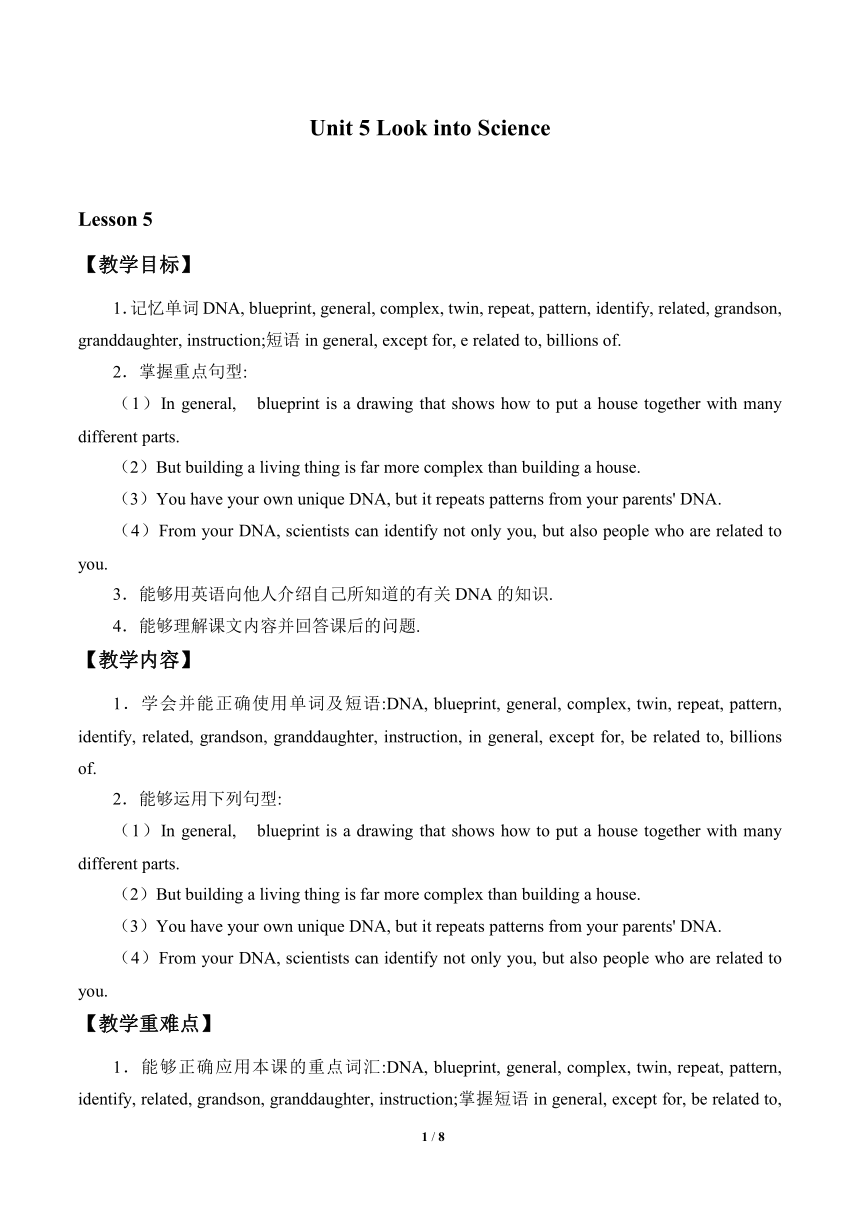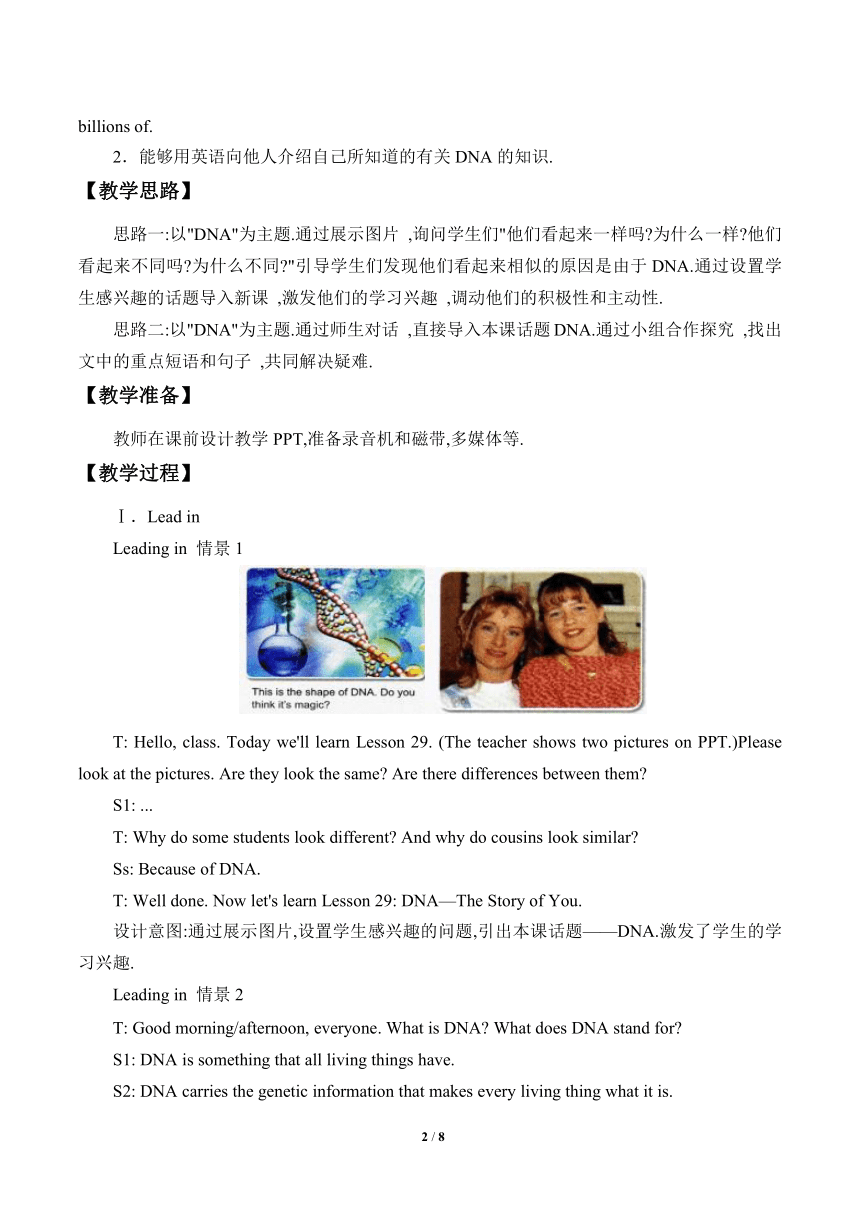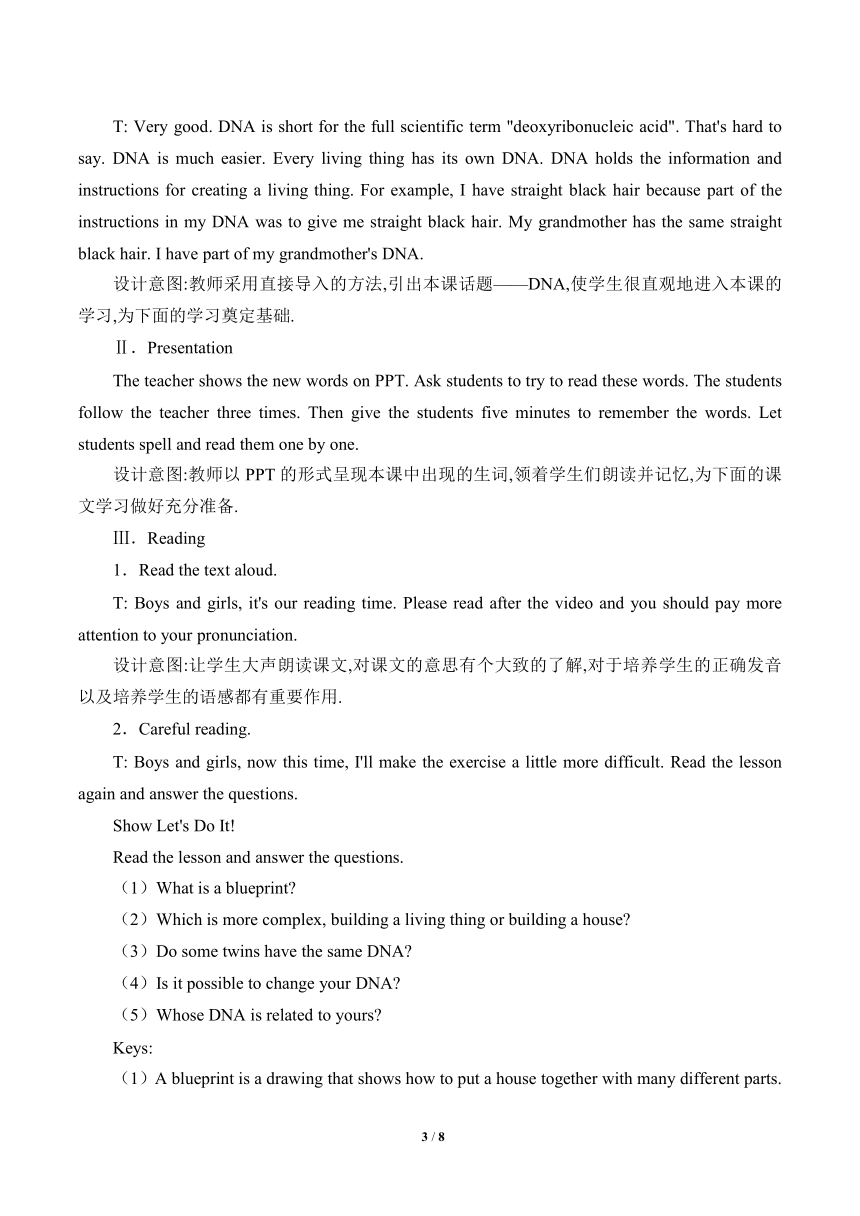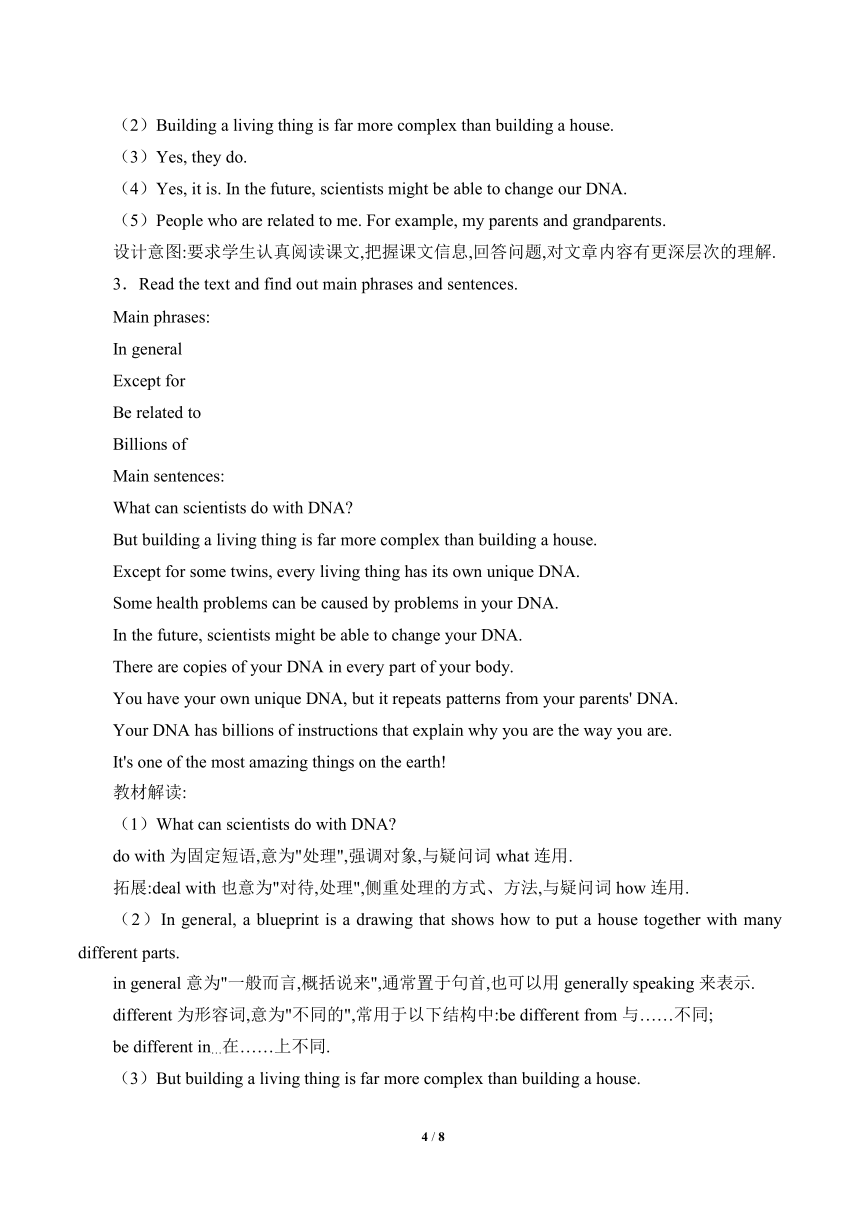冀教版英语九年级全一册 Unit 5 Look into Science Lesson 29 DNA—The Story of You教案
文档属性
| 名称 | 冀教版英语九年级全一册 Unit 5 Look into Science Lesson 29 DNA—The Story of You教案 |  | |
| 格式 | doc | ||
| 文件大小 | 165.5KB | ||
| 资源类型 | 教案 | ||
| 版本资源 | 冀教版 | ||
| 科目 | 英语 | ||
| 更新时间 | 2022-06-06 15:20:39 | ||
图片预览




文档简介
Unit 5 Look into Science
Lesson 5
【教学目标】
1.记忆单词DNA, blueprint, general, complex, twin, repeat, pattern, identify, related, grandson, granddaughter, instruction;短语in general, except for, e related to, billions of.
2.掌握重点句型:
(1)In general, blueprint is a drawing that shows how to put a house together with many different parts.
(2)But building a living thing is far more complex than building a house.
(3)You have your own unique DNA, but it repeats patterns from your parents' DNA.
(4)From your DNA, scientists can identify not only you, but also people who are related to you.
3.能够用英语向他人介绍自己所知道的有关DNA的知识.
4.能够理解课文内容并回答课后的问题.
【教学内容】
1.学会并能正确使用单词及短语:DNA, blueprint, general, complex, twin, repeat, pattern, identify, related, grandson, granddaughter, instruction, in general, except for, be related to, billions of.
2.能够运用下列句型:
(1)In general, blueprint is a drawing that shows how to put a house together with many different parts.
(2)But building a living thing is far more complex than building a house.
(3)You have your own unique DNA, but it repeats patterns from your parents' DNA.
(4)From your DNA, scientists can identify not only you, but also people who are related to you.
【教学重难点】
1.能够正确应用本课的重点词汇:DNA, blueprint, general, complex, twin, repeat, pattern, identify, related, grandson, granddaughter, instruction;掌握短语in general, except for, be related to, billions of.
2.能够用英语向他人介绍自己所知道的有关DNA的知识.
【教学思路】
思路一:以"DNA"为主题.通过展示图片 ,询问学生们"他们看起来一样吗 为什么一样 他们看起来不同吗 为什么不同 "引导学生们发现他们看起来相似的原因是由于DNA.通过设置学生感兴趣的话题导入新课 ,激发他们的学习兴趣 ,调动他们的积极性和主动性.
思路二:以"DNA"为主题.通过师生对话 ,直接导入本课话题DNA.通过小组合作探究 ,找出文中的重点短语和句子 ,共同解决疑难.
【教学准备】
教师在课前设计教学PPT,准备录音机和磁带,多媒体等.
【教学过程】
Ⅰ.Lead in
Leading in 情景1
T: Hello, class. Today we'll learn Lesson 29. (The teacher shows two pictures on PPT.)Please look at the pictures. Are they look the same Are there differences between them
S1: ...
T: Why do some students look different And why do cousins look similar
Ss: Because of DNA.
T: Well done. Now let's learn Lesson 29: DNA—The Story of You.
设计意图:通过展示图片,设置学生感兴趣的问题,引出本课话题——DNA.激发了学生的学习兴趣.
Leading in 情景2
T: Good morning/afternoon, everyone. What is DNA What does DNA stand for
S1: DNA is something that all living things have.
S2: DNA carries the genetic information that makes every living thing what it is.
T: Very good. DNA is short for the full scientific term "deoxyribonucleic acid". That's hard to say. DNA is much easier. Every living thing has its own DNA. DNA holds the information and instructions for creating a living thing. For example, I have straight black hair because part of the instructions in my DNA was to give me straight black hair. My grandmother has the same straight black hair. I have part of my grandmother's DNA.
设计意图:教师采用直接导入的方法,引出本课话题——DNA,使学生很直观地进入本课的学习,为下面的学习奠定基础.
Ⅱ.Presentation
The teacher shows the new words on PPT. Ask students to try to read these words. The students follow the teacher three times. Then give the students five minutes to remember the words. Let students spell and read them one by one.
设计意图:教师以PPT的形式呈现本课中出现的生词,领着学生们朗读并记忆,为下面的课文学习做好充分准备.
Ⅲ.Reading
1.Read the text aloud.
T: Boys and girls, it's our reading time. Please read after the video and you should pay more attention to your pronunciation.
设计意图:让学生大声朗读课文,对课文的意思有个大致的了解,对于培养学生的正确发音以及培养学生的语感都有重要作用.
2.Careful reading.
T: Boys and girls, now this time, I'll make the exercise a little more difficult. Read the lesson again and answer the questions.
Show Let's Do It!
Read the lesson and answer the questions.
(1)What is a blueprint
(2)Which is more complex, building a living thing or building a house
(3)Do some twins have the same DNA
(4)Is it possible to change your DNA
(5)Whose DNA is related to yours
Keys:
(1)A blueprint is a drawing that shows how to put a house together with many different parts.
(2)Building a living thing is far more complex than building a house.
(3)Yes, they do.
(4)Yes, it is. In the future, scientists might be able to change our DNA.
(5)People who are related to me. For example, my parents and grandparents.
设计意图:要求学生认真阅读课文,把握课文信息,回答问题,对文章内容有更深层次的理解.
3.Read the text and find out main phrases and sentences.
Main phrases:
In general
Except for
Be related to
Billions of
Main sentences:
What can scientists do with DNA
But building a living thing is far more complex than building a house.
Except for some twins, every living thing has its own unique DNA.
Some health problems can be caused by problems in your DNA.
In the future, scientists might be able to change your DNA.
There are copies of your DNA in every part of your body.
You have your own unique DNA, but it repeats patterns from your parents' DNA.
Your DNA has billions of instructions that explain why you are the way you are.
It's one of the most amazing things on the earth!
教材解读:
(1)What can scientists do with DNA
do with为固定短语,意为"处理",强调对象,与疑问词what连用.
拓展:deal with也意为"对待,处理",侧重处理的方式、方法,与疑问词how连用.
(2)In general, a blueprint is a drawing that shows how to put a house together with many different parts.
in general意为"一般而言,概括说来",通常置于句首,也可以用generally speaking来表示.
different为形容词,意为"不同的",常用于以下结构中:be different from与……不同;
be different in…在……上不同.
(3)But building a living thing is far more complex than building a house.
living为形容词,意为"活着的,活的",常作定语.
far为副词,意为"非常,远远",用来修饰形容词和副词的比较级,表示程度.
拓展:同样用法的词还有even"甚至"; rather"相当"; much"……得多"; a little/bit"有点"; a lot"……得多"等等.
(4)Except for some twins, every living thing has its own unique DNA.
except for意为"除……之外",它要求排除的是不同类的.
辨析: except for, except, besides, but
except for意为"除了",表示对主体的肯定和局部的否定,用于不同类的事物间.
except可用作介词,意为"除了……之外",表示同类事物间的排除关系.
besides可用作介词,意为"除……之外",表示同类事物间的叠加关系.
but可用作介词,意为"除……之外",常与no, all, every, each, none, nobody等词连用,有时可与except互换.
every为形容词,意为"每一的,每一个的",其后接单数名词;"every+单数名词"作主语时,谓语动词用单数;every强调整体概念,不能直接与of连用,指三者及三者以上中的每一个.
拓展:each可作形容词,意为"每个的",也可用作代词,意为"每个",each作形容词时只能作定语,其后接单数名词;"each+单数名词"或each作主语时,谓语动词用单数;
each强调个体,可与of连用,指两者及两者以上中的每一个.
注意:"every/each+单数名词+and+ every/each+单数名词"结构作主语时,谓语动词用单数形式.
own作形容词,意为"自己的",位于物主代词或名词所有格之后,还可作动词,意为"拥有",其后宾语多表示房屋、土地或财产等,其名词形式为owner,意为"物主".
(5)Some health problems can be caused by problems in your DNA.
health为不可数名词,意为"健康",常构成短语in good/bad health,意为"健康/不健康".
拓展:
healthy为形容词,意为"健康的";unhealthy意为"不健康的",keep/stay healthy意为"保持健康".
healthily为副词,意为"健康地",eat healthily意为"吃得健康".
cause为及物动词,意为"引起,导致,发生",后面可接双宾语,也可接动词不定式作宾语补足语.
拓展:cause作名词,意为"原因、起因".指导致某种结果、造成一种事实的原因,通常与of连用.
(6)In the future, scientists might be able to change your DNA.
be able to意为"能,会",表示通过努力而获得的能力,强调结果,可用于各种时态,其后接动词原形.
(7)You have your own unique DNA, but it repeats patterns from your parents' DNA.
repeat为及物动词,意为"重复,重述",后接名词或代词作宾语.
parents'意为"父母亲的",是复数名词的所有格形式.
(8)From your DNA, scientists can identify not only you, but also people who are related to you.
identify为及物动词,意为"确认,识别,鉴别",后接名词或代词作宾语.
be related to意为"和……有联系,和……有关,与……有亲戚关系".related为形容词,意为"有关的、相关的".relate为动词,意为"把……联系起来",常与to或with搭配.
(9)Your DNA has billions of instructions that explain why you are the way you are.
本句句末的you are是the way的定语从句.the way的定语从句的引导词可用in which,或用that,也可以不用引导词.way在本句中意为"情况、状态".
(10)It's one of the most amazing things on the earth!
one of the most amazing things意为"最令人惊奇的事情之一",为"one of the+形容词的最高级+复数名词"结构.其中定冠词the也可使用形容词性的物主代词来代替.
设计意图:学生是学习的主体,教师要努力调动学生学习的积极性和主动性,通过组内合作讨论、探究,找出课文中的关键单词、短语和句子,把所学的知识转化为学习能力.
Ⅳ.Task
1.Show Let's Do It!
Is it a good idea to change the DNA of the food we eat Some people say doing this makes our food better. Others think it's too dangerous. Search the Internet for information and write down your ideas.
2.Have the students consider the questions in Let's Do It! No. 4.
3.Have them complete this task and research genetically modified food. Their research should answer the following questions:
Do you think it's a good idea to change the DNA of the food we eat Why or why not
What are some of the positives of genetically modified food
What are some of the negatives of genetically modified food
4.Have the groups present their research in the form of a commercial that is either advertising the continuation of genetically modified food or the end of it.
设计意图:锻炼学生的口语表达与写作能力,同时培养学生的合作意识.
Ⅴ.Practice
1.Show Let's Do It! No. 2.
Fill in the blanks with the phrases in the box.
in general, except for, not only…but also, related to, even if, the same…as…
(1)Your homework is quite good ______ a few spelling mistakes.
(2)______ the young ______ the old like pop music.
(3)Kate's hair is ______ color ______ her sister's.
(4)______, women live longer than men.
(5)______ many difficulties remain, we can overcome them.
(6)Is wealth ______ happiness
2.Complete the passage with the sentences in the box.
Changing DNA
Do you know DNA can be changed Have you ever seen a pig with a dog's body Of course not! Pigs and dogs can't have babies together. ______ but now, scientists can do it. Scientists can take DNA from one kind of animal and put it into another kind of animal. They can design new plants by combining the DNA of other plants. ______ Some scientists are worried. They say we need to know more about DNA before we start changing it. ______ But what if the plants are bad for humans, too
A.Their DNA can't combine.
B.We can make plants that are bad for pests.
C.They can even combine the DNA of a plant and an animal.
3.同义句转换
(1)Both you and Linda give us a big surprise.
_______ _______you_______ _______Linda _______ us a big surprise.
(2)It takes me half an hour to clean up my room.
I _______half an hour _______ up my room.
(3)My book isn't the same as his.
My book is_______ _______his.
(4)What do you do with this problem
_______do you _______ with this problem
(5)He can speak Chinese.
He is ______________speak Chinese.
(6)I don't know how I could build a house.
I don't know how_______ _______a house.
Keys:Ⅰ.1.except for 2.Not only, but also 3.the same, as 4.In general 5.Even if 6.related to
Ⅱ.A,C,B
Ⅲ.1.Not only, but also, gives 2.Spend, cleaning
3.different from 4.How, deal 5.able to 6.to build
设计意图:在掌握了课文中的重点句子和短语之后,做词汇、句子、短文练习,能有效巩固本课所学知识点.
Ⅵ.Summary
In this class, we've learned DNA.
设计意图:给学生总结,让学生明确这节课的学习内容.
Homework
1.Finish off the exercises in the activity book.
2.Preview Lesson 30.
设计意图:让学生通过习题巩固本节课知识点,并提前做好预习.
7 / 8
Lesson 5
【教学目标】
1.记忆单词DNA, blueprint, general, complex, twin, repeat, pattern, identify, related, grandson, granddaughter, instruction;短语in general, except for, e related to, billions of.
2.掌握重点句型:
(1)In general, blueprint is a drawing that shows how to put a house together with many different parts.
(2)But building a living thing is far more complex than building a house.
(3)You have your own unique DNA, but it repeats patterns from your parents' DNA.
(4)From your DNA, scientists can identify not only you, but also people who are related to you.
3.能够用英语向他人介绍自己所知道的有关DNA的知识.
4.能够理解课文内容并回答课后的问题.
【教学内容】
1.学会并能正确使用单词及短语:DNA, blueprint, general, complex, twin, repeat, pattern, identify, related, grandson, granddaughter, instruction, in general, except for, be related to, billions of.
2.能够运用下列句型:
(1)In general, blueprint is a drawing that shows how to put a house together with many different parts.
(2)But building a living thing is far more complex than building a house.
(3)You have your own unique DNA, but it repeats patterns from your parents' DNA.
(4)From your DNA, scientists can identify not only you, but also people who are related to you.
【教学重难点】
1.能够正确应用本课的重点词汇:DNA, blueprint, general, complex, twin, repeat, pattern, identify, related, grandson, granddaughter, instruction;掌握短语in general, except for, be related to, billions of.
2.能够用英语向他人介绍自己所知道的有关DNA的知识.
【教学思路】
思路一:以"DNA"为主题.通过展示图片 ,询问学生们"他们看起来一样吗 为什么一样 他们看起来不同吗 为什么不同 "引导学生们发现他们看起来相似的原因是由于DNA.通过设置学生感兴趣的话题导入新课 ,激发他们的学习兴趣 ,调动他们的积极性和主动性.
思路二:以"DNA"为主题.通过师生对话 ,直接导入本课话题DNA.通过小组合作探究 ,找出文中的重点短语和句子 ,共同解决疑难.
【教学准备】
教师在课前设计教学PPT,准备录音机和磁带,多媒体等.
【教学过程】
Ⅰ.Lead in
Leading in 情景1
T: Hello, class. Today we'll learn Lesson 29. (The teacher shows two pictures on PPT.)Please look at the pictures. Are they look the same Are there differences between them
S1: ...
T: Why do some students look different And why do cousins look similar
Ss: Because of DNA.
T: Well done. Now let's learn Lesson 29: DNA—The Story of You.
设计意图:通过展示图片,设置学生感兴趣的问题,引出本课话题——DNA.激发了学生的学习兴趣.
Leading in 情景2
T: Good morning/afternoon, everyone. What is DNA What does DNA stand for
S1: DNA is something that all living things have.
S2: DNA carries the genetic information that makes every living thing what it is.
T: Very good. DNA is short for the full scientific term "deoxyribonucleic acid". That's hard to say. DNA is much easier. Every living thing has its own DNA. DNA holds the information and instructions for creating a living thing. For example, I have straight black hair because part of the instructions in my DNA was to give me straight black hair. My grandmother has the same straight black hair. I have part of my grandmother's DNA.
设计意图:教师采用直接导入的方法,引出本课话题——DNA,使学生很直观地进入本课的学习,为下面的学习奠定基础.
Ⅱ.Presentation
The teacher shows the new words on PPT. Ask students to try to read these words. The students follow the teacher three times. Then give the students five minutes to remember the words. Let students spell and read them one by one.
设计意图:教师以PPT的形式呈现本课中出现的生词,领着学生们朗读并记忆,为下面的课文学习做好充分准备.
Ⅲ.Reading
1.Read the text aloud.
T: Boys and girls, it's our reading time. Please read after the video and you should pay more attention to your pronunciation.
设计意图:让学生大声朗读课文,对课文的意思有个大致的了解,对于培养学生的正确发音以及培养学生的语感都有重要作用.
2.Careful reading.
T: Boys and girls, now this time, I'll make the exercise a little more difficult. Read the lesson again and answer the questions.
Show Let's Do It!
Read the lesson and answer the questions.
(1)What is a blueprint
(2)Which is more complex, building a living thing or building a house
(3)Do some twins have the same DNA
(4)Is it possible to change your DNA
(5)Whose DNA is related to yours
Keys:
(1)A blueprint is a drawing that shows how to put a house together with many different parts.
(2)Building a living thing is far more complex than building a house.
(3)Yes, they do.
(4)Yes, it is. In the future, scientists might be able to change our DNA.
(5)People who are related to me. For example, my parents and grandparents.
设计意图:要求学生认真阅读课文,把握课文信息,回答问题,对文章内容有更深层次的理解.
3.Read the text and find out main phrases and sentences.
Main phrases:
In general
Except for
Be related to
Billions of
Main sentences:
What can scientists do with DNA
But building a living thing is far more complex than building a house.
Except for some twins, every living thing has its own unique DNA.
Some health problems can be caused by problems in your DNA.
In the future, scientists might be able to change your DNA.
There are copies of your DNA in every part of your body.
You have your own unique DNA, but it repeats patterns from your parents' DNA.
Your DNA has billions of instructions that explain why you are the way you are.
It's one of the most amazing things on the earth!
教材解读:
(1)What can scientists do with DNA
do with为固定短语,意为"处理",强调对象,与疑问词what连用.
拓展:deal with也意为"对待,处理",侧重处理的方式、方法,与疑问词how连用.
(2)In general, a blueprint is a drawing that shows how to put a house together with many different parts.
in general意为"一般而言,概括说来",通常置于句首,也可以用generally speaking来表示.
different为形容词,意为"不同的",常用于以下结构中:be different from与……不同;
be different in…在……上不同.
(3)But building a living thing is far more complex than building a house.
living为形容词,意为"活着的,活的",常作定语.
far为副词,意为"非常,远远",用来修饰形容词和副词的比较级,表示程度.
拓展:同样用法的词还有even"甚至"; rather"相当"; much"……得多"; a little/bit"有点"; a lot"……得多"等等.
(4)Except for some twins, every living thing has its own unique DNA.
except for意为"除……之外",它要求排除的是不同类的.
辨析: except for, except, besides, but
except for意为"除了",表示对主体的肯定和局部的否定,用于不同类的事物间.
except可用作介词,意为"除了……之外",表示同类事物间的排除关系.
besides可用作介词,意为"除……之外",表示同类事物间的叠加关系.
but可用作介词,意为"除……之外",常与no, all, every, each, none, nobody等词连用,有时可与except互换.
every为形容词,意为"每一的,每一个的",其后接单数名词;"every+单数名词"作主语时,谓语动词用单数;every强调整体概念,不能直接与of连用,指三者及三者以上中的每一个.
拓展:each可作形容词,意为"每个的",也可用作代词,意为"每个",each作形容词时只能作定语,其后接单数名词;"each+单数名词"或each作主语时,谓语动词用单数;
each强调个体,可与of连用,指两者及两者以上中的每一个.
注意:"every/each+单数名词+and+ every/each+单数名词"结构作主语时,谓语动词用单数形式.
own作形容词,意为"自己的",位于物主代词或名词所有格之后,还可作动词,意为"拥有",其后宾语多表示房屋、土地或财产等,其名词形式为owner,意为"物主".
(5)Some health problems can be caused by problems in your DNA.
health为不可数名词,意为"健康",常构成短语in good/bad health,意为"健康/不健康".
拓展:
healthy为形容词,意为"健康的";unhealthy意为"不健康的",keep/stay healthy意为"保持健康".
healthily为副词,意为"健康地",eat healthily意为"吃得健康".
cause为及物动词,意为"引起,导致,发生",后面可接双宾语,也可接动词不定式作宾语补足语.
拓展:cause作名词,意为"原因、起因".指导致某种结果、造成一种事实的原因,通常与of连用.
(6)In the future, scientists might be able to change your DNA.
be able to意为"能,会",表示通过努力而获得的能力,强调结果,可用于各种时态,其后接动词原形.
(7)You have your own unique DNA, but it repeats patterns from your parents' DNA.
repeat为及物动词,意为"重复,重述",后接名词或代词作宾语.
parents'意为"父母亲的",是复数名词的所有格形式.
(8)From your DNA, scientists can identify not only you, but also people who are related to you.
identify为及物动词,意为"确认,识别,鉴别",后接名词或代词作宾语.
be related to意为"和……有联系,和……有关,与……有亲戚关系".related为形容词,意为"有关的、相关的".relate为动词,意为"把……联系起来",常与to或with搭配.
(9)Your DNA has billions of instructions that explain why you are the way you are.
本句句末的you are是the way的定语从句.the way的定语从句的引导词可用in which,或用that,也可以不用引导词.way在本句中意为"情况、状态".
(10)It's one of the most amazing things on the earth!
one of the most amazing things意为"最令人惊奇的事情之一",为"one of the+形容词的最高级+复数名词"结构.其中定冠词the也可使用形容词性的物主代词来代替.
设计意图:学生是学习的主体,教师要努力调动学生学习的积极性和主动性,通过组内合作讨论、探究,找出课文中的关键单词、短语和句子,把所学的知识转化为学习能力.
Ⅳ.Task
1.Show Let's Do It!
Is it a good idea to change the DNA of the food we eat Some people say doing this makes our food better. Others think it's too dangerous. Search the Internet for information and write down your ideas.
2.Have the students consider the questions in Let's Do It! No. 4.
3.Have them complete this task and research genetically modified food. Their research should answer the following questions:
Do you think it's a good idea to change the DNA of the food we eat Why or why not
What are some of the positives of genetically modified food
What are some of the negatives of genetically modified food
4.Have the groups present their research in the form of a commercial that is either advertising the continuation of genetically modified food or the end of it.
设计意图:锻炼学生的口语表达与写作能力,同时培养学生的合作意识.
Ⅴ.Practice
1.Show Let's Do It! No. 2.
Fill in the blanks with the phrases in the box.
in general, except for, not only…but also, related to, even if, the same…as…
(1)Your homework is quite good ______ a few spelling mistakes.
(2)______ the young ______ the old like pop music.
(3)Kate's hair is ______ color ______ her sister's.
(4)______, women live longer than men.
(5)______ many difficulties remain, we can overcome them.
(6)Is wealth ______ happiness
2.Complete the passage with the sentences in the box.
Changing DNA
Do you know DNA can be changed Have you ever seen a pig with a dog's body Of course not! Pigs and dogs can't have babies together. ______ but now, scientists can do it. Scientists can take DNA from one kind of animal and put it into another kind of animal. They can design new plants by combining the DNA of other plants. ______ Some scientists are worried. They say we need to know more about DNA before we start changing it. ______ But what if the plants are bad for humans, too
A.Their DNA can't combine.
B.We can make plants that are bad for pests.
C.They can even combine the DNA of a plant and an animal.
3.同义句转换
(1)Both you and Linda give us a big surprise.
_______ _______you_______ _______Linda _______ us a big surprise.
(2)It takes me half an hour to clean up my room.
I _______half an hour _______ up my room.
(3)My book isn't the same as his.
My book is_______ _______his.
(4)What do you do with this problem
_______do you _______ with this problem
(5)He can speak Chinese.
He is ______________speak Chinese.
(6)I don't know how I could build a house.
I don't know how_______ _______a house.
Keys:Ⅰ.1.except for 2.Not only, but also 3.the same, as 4.In general 5.Even if 6.related to
Ⅱ.A,C,B
Ⅲ.1.Not only, but also, gives 2.Spend, cleaning
3.different from 4.How, deal 5.able to 6.to build
设计意图:在掌握了课文中的重点句子和短语之后,做词汇、句子、短文练习,能有效巩固本课所学知识点.
Ⅵ.Summary
In this class, we've learned DNA.
设计意图:给学生总结,让学生明确这节课的学习内容.
Homework
1.Finish off the exercises in the activity book.
2.Preview Lesson 30.
设计意图:让学生通过习题巩固本节课知识点,并提前做好预习.
7 / 8
同课章节目录
- Unit 1 Stay Healthy
- Lesson 1 What's Wrong,Danny?
- Lesson 2 A Visit to the Dentist
- Lesson 3 Good Food, Good Health
- Lesson 4 Don't Smoke, Please!
- Lesson 5 Jane's Lucky Life
- Lesson 6 Stay Away from the Hospital
- Unit Review
- Unit 2 Great People
- Lesson 7 What Is the Meaning of Lift?
- Lesson 8 A Universe of Thought
- Lesson 9 China's Most Famous "Farmer"
- Lesson 10 Touch the World
- Lesson 11 To China, with Love
- Lesson 12 Guess My Hero!
- Unit Review
- Unit 3 Safety
- Lesson 13 Be Careful,Danny!
- Lesson 14 Accidents Happen
- Lesson 15 My Helmet Saved My Life!
- Lesson 16 How Safe Is Your Home?
- Lesson 17 Staying Safe in an Earthquake
- Lesson 18 Never Catch a Dinosaur
- Unit Review
- Unit 4 Stories and poems
- Lesson 19 A Story or a Poem?
- Lesson 20 Say It in Five
- Lesson 21 The Fable of the Woodcutte
- Lesson 22 The Giant(Ⅰ)
- Lesson 23 The Giant(Ⅱ)
- Lesson 24 Writing a Poem
- Unit Review
- Unit 5 Look into Science
- Lesson 25 Let's Do an Experiment!
- Lesson 26 Keep the Candle Burning
- Lesson 27 Planet Danny
- Lesson 28 The Study of Living Things
- Lesson 29 DNA—The Story of You
- Lesson 30 Science Affects Us
- Unit Review
- Unit 6 Movies and Theate
- Lesson 31 A movie or a Play
- Lesson 32 Moving Pictures
- Lesson 33 The Fisherman and the Goldfish(Ⅰ)
- Lesson 34 The Fisherman and the Goldfish(Ⅱ)
- Lesson 35 Theatres Are Fun!
- Lesson 36 Making Plays Is Fun
- Unit Review
